This post may include affiliate links. Thank you for your support.
This Udon Stir-Fry recipe is made in one pan and ready in 20 minutes or less! Featuring thick, silky udon noodles and pork (or your choice of protein) tossed in a delicious savory, slightly sweet and spicy 5-ingredient yaki udon sauce! These udon noodles are totally customizable – add any vegetables you love, or omit the meat and substitute tofu or mushrooms! Everyone will fall in love with these fast and ultra-flavorful Japanese stir fried udon noodles!
Hi, friends! If you are a fan of fast and flavorful meals, you are going to fall in love with this recipe! These udon noodles are the perfect quick meal – they require very little effort and deliver big flavor!
Table of Contents
- About this udon noodle recipe
- What is udon stir fry?
- What do I need to make pork udon noodles?
- What are udon noodles?
- What vegetables can I add to pork udon noodles?
- How to make yaki udon noodle stir fry?
- Serving suggestions for pork udon noodles
- How to properly store and reheat udon
- More noodle stir fry recipes!
- Udon Stir-Fry recipe
About this udon noodle recipe
These noodles are the ultimate blend of delicious flavor, wonderfully slurp-able texture and umami goodness! It’s quick, cozy comfort food at its finest!
This recipe features generous-size pieces of tender meat and thick, plump, chewy udon noodles along with flavorful aromatics in a savory, slightly spicy stir-fry sauce. While I love succulent pork, this recipe is totally customizable! You can easily make this stir-fried udon recipe with your favorite protein and add in whatever vegetables you love! Or omit the meat entirely and substitute mushrooms or tofu to create a vegetarian dish!
Aside from the crave-able flavor and wonderful silky, chewy texture, these saucy Japanese noodles are so simple to prepare! Everything comes together in just one pan in under 30 minutes (from prep to finish)!
These delicious, savory noodles are truly swoon-worthy! From the delightfully toothsome noodles to the umami-packed sauce and the aromatic fresh herbs, everything about this dish just screams gloriously yummy! And, since everything comes together in a snap, these udon noodles are perfect for quick weeknight meals! Oh, and the leftovers are superb for grab-and-go lunches (if you are lucky enough to have any leftovers)!
If you’re looking for more fuss-free, fast stir fry dinners, try these recipes next: Steak Zucchini Stir Fry, Chinese Stir Fry with Ground Beef, Lemon Chicken Stir Fry, Cabbage Stir Fried, and Beef and Orange Stir Fry.
Why you’ll love this recipe
- Quick and easy! This udon stir-fry is ridiculously simple and fast to prepare! You can have this dish prepped, ready and on the table in 30 minutes or less!
- 5 ingredient stir-fry sauce! This yaki udon sauce only requires 5 ingredients!
- Amazing flavor! This pork stir-fry is incredibly flavorful – it’s savory, slightly spicy, a little sweet and overflowing with umami flavor!
- The best texture! These saucy, thick, plump, silky noodles are soft, chewy, delightfully toothsome, and soak up the flavorful sauce perfectly!
- Totally customizable! Consider this recipe a build your own udon noodle bowl! You can easily customize this flexible recipe! Try swapping the pork for turkey, chicken, or beef, and throw in your favorite fresh vegetables! Or swap the meat out entirely and use tofu or mushrooms for a vegetarian meal! This udon stir-fry is a great way to use up any leftover vegetables or protein you have hanging out in your refrigerator!
What is udon stir fry?
Udon stir-fry, also known as yaki udon (焼きうどん) , is a popular Japanese stir-fry noodle dish. Traditionally, yaki udon consists of with meat (chicken, beef or pork) and a variety of fresh vegetables tossed and stir-fried in a savory, slightly sweet soy sauce and mirin-based sauce.
Yaki udon translates to “fried udon” – ‘yaki’ meaning fry and ‘udon’ indicating the type of noodle in the dish.
While stir-fry udon is a popular Japanese street food often found in festivals and Japanese pubs (Izakayas); you can now find countless variations of this dish worldwide.
What do I need to make pork udon noodles?
This stir-fry pork noodles recipe require mostly pantry basics, along with pork (or your choice of protein) and udon noodles! Below is a list of the ingredients you will need to make this recipe.
Ingredients in this yaki udon recipe
- Stir-fry Sauce: A combination of simple Asian ingredients – gochujang, soy sauce, mirin, rice vinegar and brown sugar – creates a deliciously rich, savory, slightly sweet and spicy stir-fry sauce! You can easily adjust the ingredients to customize the sauce to your specific taste! (Please see below for a complete description of the sauce ingredients!)
- Udon Noodles: You can use fresh or frozen udon noodles for this recipe. I personally prefer using fresh shelf-stable udon noodles as they are easiest to find. (Please see below for a complete description of udon noodles and substitutions!)
- Sesame Oil: Sesame oil adds a deeply earthy, nutty, rich flavor and helps prevent the udon noodles from sticking together. Be sure to use toasted sesame oil for the most flavor.
- Oil: I recommend using peanut oil for stir-frying pork noodles! It has a high smoke point, and the slightly nutty flavor works great in this recipe. (Please see below for substitutions.)
- Pork: You will need 1 pound of ground pork for this recipe. I recommend using lean pork for this recipe. (Please see below for substitutions!)
- Aromatics: A combination of garlic, ginger, and scallions all provide fragrance and umami flavor!
- Tomato Paste: Tomato paste adds a layer of complex, robust flavor!
- Seasonings: Kosher salt and ground black pepper add plenty of flavor!
What sauce for Japanese noodles?
The savory, umami stir-fry sauce is one of the major components of yaki udon! The sauce is what provides the dish with so much flavor! A simple search of the internet will provide countless variations of yaki udon sauces. However, this sauce is the perfect mix of savory, slightly sweet, spicy, and complex – with plenty of umami flavor!
Ingredients in udon stir-fry sauce
- Gochujang: Gochujang is a Korean hot chili paste. It’s made with red chili, glutinous rice and soybeans. This fermented Korean condiment adds a depth of rich, slightly spicy flavor. You can find gochujang in the international aisle of most major grocery stores or you can purchase it online (Amazon)!
- Soy Sauce: Soy sauce adds a slightly salty, umami flavor to the stir-fry sauce. Make sure you use reduced-sodium soy sauce so you can control the saltiness of your dish.
- Rice Vinegar: Vinegar helps balance out the sauce while providing a delicate, slightly sweet flavor. I recommend using unseasoned rice vinegar in this recipe!
- Mirin: With a sweet and tangy flavor, this liquid seasoning brings umami to stir fry noodle sauce.
- Light Brown Sugar: Light brown sugar adds the perfect amount of rich sweetness to the sauce!
Substitutions and variations
- Udon Noodles: If you can’t find udon noodles, you can substitute bucatini! However, you will need to cook the bucatini prior – make sure you undercook the pasta by 1-2 minutes to ensure your noodles don’t turn mushy during the stir-frying process.
- Oil: You can substitute a neutral oil, such as vegetable or canola for peanut oil if you prefer!
- Pork: You can substitute the pork with your favorite protein! Ground beef, chicken and turkey are all great options; however, feel free to use tofu or shrimp if you prefer!
- Chili Paste: Unfortunately, there is no great substitute for Gochujang. However, you can substitute it with Sambal Oelek, Sriracha, or a homemade chili pepper paste if you are in a pinch. Please note that all the substitutions will lack the complexity and depth of flavor found in Gochujang. To make ¼ cup of paste, moisten 4 tablespoons of red chili pepper flakes with a bit of soy sauce and season with a 1/8 teaspoon of granulated sugar. Mix well until combined and paste-like.
- Vegetables: Please see below for a list of fresh vegetables you can add to this stir-fry udon recipe!
What are udon noodles?
Udon is a thick, long, soft, and chewy Japanese noodle made from wheat flour, water and salt. Japanese udon noodles can be either flat or round, and you can purchase them fresh, frozen or dried. Udon is an incredible versatile ingredient as they can be prepared in a variety of ways and served either hot or cold!
Below are a few popular Japanese udon dishes.
- Yaki Udon (this recipe): Stir-fried silky udon noodles and vegetables in a soy and mirin-based sauce. Yaki udon can be vegan, vegetarian, or made with meat (as seen here).
- Kake Udon: This dish is one of the simplest ways to serve udon – noodles in a broth made of dashi, soy sauce and mirin.
- Curry Udon: This Japanese dish features udon noodles coated in a thick Japanese curry.
How to buy udon noodles: varieties of udon
There are three types of udon noodles – fresh, frozen or dry. I recommend using fresh or frozen udon for stir-frying.
- Fresh Shelf-Stable: Ideally, you want fresh (pre-cooked) udon noodles for this recipe. Fresh noodles can be found in soft, vacuum-sealed packages in the international aisle of most major grocery stores. This variety of udon is convenient and incredibly easy to work with! Before using the udon noodles, I recommend soaking them in hot water to loosen and separate the noodles.
- Fresh Refrigerated: Fresh, refrigerated udon noodles are almost identical to the shelf-stable noodles, as they come in a soft vacuum-sealed package; however, they are kept cold versus shelf-stable. Fresh refrigerated udon can be a bit harder find than shelf-stable noodles. You can typically find them located in the refrigerated section of most Asian or specialty grocery stores.
- Frozen: Packages of frozen segmented blocks of udon noodles can be found in the freezer section of most Asian grocery stores. I tend to steer clear of frozen udon noodles, because they lack the same toothsome quality found in the fresh varieties. Also, you will need to soak the noodles in boiling water, and I would rather not wait for water to boil. However, if you plan on using frozen noodles, make sure you slightly undercook the noodles (according to package instructions) to prevent them from becoming mushy after stir-frying!
- Dried: Packages of dried udon noodles (they look similar to Italian pastas) are thinner, shorter and do not hold up well to this rich sauce. Also, dried udon noodles tend to either lack the same tooth-some texture or become quite soggy during stir-frying. Therefore, I do not recommend using dry udon noodles for this recipe. If you can only find dry udon, I recommend swapping the udon out for thick bucatini noodles instead!
What vegetables can I add to pork udon noodles?
This udon noodle stir fry recipe is incredibly flexible! There are various vegetables you can add, so please feel free to customize this recipe to your liking! I recommend using this recipe as a guide! Add whatever vegetables your family loves, or simply any fresh veggies that you have lying around!
Expert tips for adding vegetables
- Make sure you cut your vegetables into uniform sizes, so everything cooks evenly, and your stir fry is easier to eat!
- When adding vegetables to a stir-fry, make sure you add the vegetables to the pan in terms of cook time – starting with the longest cooking vegetable first and ending with the quickest cooking. For example, always add onions first, followed by any hard vegetables, such as broccoli and peppers. Quick-cooking vegetables, such as cabbage should be added towards the very end of cooking.
- If you are adding a lot of vegetables, you will need to increase the sauce. I recommend simply doubling the amounts of each sauce ingredient to make life easy!
Fresh vegetables to use in udon
- Onions: Onions are the most common vegetable to add to pork udon. They add a delicious, assertive flavor that complements the spicy, savory sauce.
- Broccoli: Crunchy broccoli is a popular vegetable to add to stir-fries as it’s always easy to find fresh at the store!
- Carrots: Carrots add a delightful crunchy texture and sweet flavor to udon noodles! I recommend finely shredding carrots for the best results.
- Mushrooms: Fresh mushrooms are a great way to add an extra earthy, umami flavor to your noodles!
- Snow Peas: Snow peas, also known as Chinese pea pods, are a classic way to add a fresh, slightly sweet taste to your dish!
- Bell Peppers: Bell peppers are a delicious addition to udon noodles! I prefer to use sweet red bell peppers (versus green); however, you can use whatever color you like!
- Cabbage: Fresh cabbage is a wonderful addition! Make sure you thinly slice the cabbage and add it towards the end as it’s incredibly quick cooking!
- Zucchini: Zucchini, with its mild flavor and soft texture, is a delicious addition if you are looking to sneak in more vegetables for kids!
- Bamboo Shoots: Bamboo shoots, also known as bamboo sprouts, are a popular ingredient in Asian stir-fries. They add a pleasant crunchy, yet tender texture and sweet flavor!
How to make yaki udon noodle stir fry?
This pork udon recipe is so quick and easy to prepare – everything comes together in one pan in 30 minutes or less!
- Mix the sauce: In a 1-cup measure or small bowl, whisk together the yaki udon stir-fry sauce. Set the sauce aside.
- Soak the noodles: Add the noodles to a large bowl and cover with HOT water. Gently press the noodles down to completely submerge them. Soak noodles for 2-3 minutes, stirring to loosen and separate the noodles. Drain in a colander. Transfer the noodles back to the bowl and toss with the sesame oil. Set the noodles aside.
- Brown pork (or protein of choice): Heat the peanut oil in a wok or large skillet. Add the pork and season to taste with salt and pepper. Cook until the pork is well brown on the under-side, about 3 minutes. Turn the pork over and use a wooden spoon to break the pork into bite-size pieces. Cook, stirring occasionally, until the pork is no longer pink, about 2-3 additional minute.
- Add the aromatics: Add the scallions (light green parts only), garlic and ginger. Cook, stirring, until aromatic, about 1 minute. Add in the tomato paste and cook, stirring occasionally, for 2 minutes.
- Add the sauce: Add the sauce and scrape up any brown bits stuck to the bottom of the pan. Bring to a simmer and cook for 2 minutes, or until the sauce is thick.
- Add the noodles: Add the noodles to the pan and cook, tossing constantly, until the sauce clings to the noodles, about 1-2 minutes. Remove from heat.
- Serve: Squeeze fresh lime wedges over the spicy pork and noodles; toss to combine. Divide the dish among serving plates and garnish with fresh herbs and sesame seeds. Enjoy!
Expert tips for the best udon stir fry
- Mis en place: Before you start stir-frying udon, make sure you gather and prepare all your ingredients, especially if you plan on adding vegetables! Stir-frying is a very fast process, so it’s important to have everything you need ready to go!
- Use fresh or frozen noodles: For the best texture, I recommend using fresh, pre-cooked (shelf-stable or refrigerated) udon noodles; however, frozen will work as well. Dry udon noodles are typically lacking in texture.
- Soak fresh noodles: Make sure you soak your fresh udon noodles in hot water to help loosen and separate the noodles.
- Toss noodles in sesame oil before frying: After soaking your noodles, be sure to thoroughly drain them and then toss them in a bit of sesame oil! Sesame oil will help prevent the noodles from sticking together and it adds a delicious nutty, umami flavor!
- Cooking pan: A wok is the traditional pan for stir-frying udon; however, you can use a skillet – just make sure your pan is large with high sides! Never attempt to use a small pan for stir-frying or you will end up over-crowding the pan. Over-crowding the pan will lead to steaming versus frying!
- Use fresh garnishes to taste: Fresh herbs, seeds, nuts, and a fresh squeeze of lime juice help bring all the flavors to life!! Plus, garnishes are a great way to customize udon noodles to your specific taste! I like to add sesame seeds, cilantro, roasted peanuts, and plenty of lime juice, but feel free to add your favorites!
How to make pork udon noodles step-by-step photos
(Don’t forget to scroll down for the detailed instructions in the complete printable recipe card at the bottom of the page!)
Serving suggestions for pork udon noodles
Are you looking for a delicious side dish (or two) to serve with your yaki udon? Below are a few easy Asian side dish options to help round out your meal!
14 delicious dishes to serve with udon stir-fry
- Carrot Dip: Creamy, rich carrot dip offers up a umami flavor that pairs wonderfully with this Japanese udon stir-fry!
- Edamame: A steaming bowl of salty edamame is one of my favorite sides to serve with udon!
- Soup: A brothy soup, such as Miso, Wonton or Egg Drop, is a delicious light side option for pork noodles!
- Ginger Salad: Sweet and slightly peppery Asian-American ginger salad perfectly complements the flavors in this stir-fry!
- Avocado Salad: Creamy, rich avocado salad offers a cooling flavor that deliciously contrasts this spicy pork!
- Egg Rolls: Shatteringly crisp fried egg rolls (spring rolls) are a great way to add a bit of crunch to your meal!
- Summer Rolls: Fresh summer rolls are a wonderful, healthier alternative to egg rolls!
- Dumplings: Soft, plump dumplings are a dreamy addition to this meal!
- Chicken Wings: Sticky, saucy Asian chicken wings are a must for wing lovers!
- Broccoli: If you prefer to serve your vegetables on the side (versus in the stir fry), try serving Chinese broccoli as a side dish!
- Green Beans: Stir-fried green beans are another winning vegetable side dish!
- Asian dishes: Make it an Asian-themed chow down and serve your udon with your favorite Asian dishes, like Fried Rice with Salmon, Sriracha Salmon, or Shrimp with Ramen.
- Fruit: Fresh oranges and pineapples can double as a side dish or a dessert! Macerate fruit for the best, juicy flavor!
- Fortune Cookies: Give store-bought fortune cookies a homemade upgrade by dipping them in melted chocolate and dusting them in colorful sprinkles!
How to properly store and reheat udon
Food safety is of the utmost importance, especially when it comes to storing and reheating your leftovers! Please follow the simple tips below to ensure you properly store and reheat your udon noodle stir fry!
How long will udon stir fry keep?
Leftover pork udon is perfect to have on hand for easy grab-and-go lunches and quick heat-and-eat dinners!
To properly store leftovers, first allow the udon noodles to cool completely to room temperature; however, do not leave them out for more than 2 hours! Once cool, transfer the leftovers to an airtight container and store in the refrigerator for up to four days.
Can you freeze leftover udon noodles?
I do not recommend freezing udon stir-fry; unfortunately, the noodles become mushy and soft upon thawing. If you have leftovers, I recommend storing them in the refrigerator according to the instructions above.
These fast and flavorful Japanese udon noodles are thick, chewy, super saucy and totally crave-worthy! Forget the take out – create your own yaki udon with this simple recipe and your choice of vegetables and protein!
Until next week, friends, cheers!
Cheyanne
Craving MORE? Follow all the deliciousness on Facebook, Pinterest and Instagram!
More noodle stir fry recipes!
The best Japanese stir fried udon noodles👇

Udon Stir-Fry recipe
Equipment
- 1-Cup Measure or Small Bowl
- Wok or Large Skillet
Ingredients
- 1/3 cup Low-Sodium Soy Sauce
- ¼ cup Gochujang (or hot chili paste) – or more to taste (SEE NOTES)
- 3 1/2 TBS Light Brown Sugar – packed
- 1 TBS Mirin
- 1 tsp Unseasoned Rice Vinegar
- 2 (7-ounce) packages Udon Stir-Fry Noodles (SEE NOTES)
- 2 tsp Toasted Sesame Oil
- 2 TBS Peanut Oil – or neutral oil, such as canola or vegetable (for stir-frying)
- 1 pound Lean Ground Pork (or lean ground beef, turkey or chicken)
- 1 bunch Scallions – thinly sliced and separated (about ½ cup light green parts for stir-frying and dark green parts for garnish)
- 3-4 cloves Garlic – peeled & thinly sliced
- 2 tsp Fresh Ginger – grated (from 1-inch knob)
- 1 TBS Tomato Paste
- Kosher Salt & Ground Black Pepper
- Serving Suggestions: Sesame Seeds, Cilantro or Torn basil, Sesame Oil, Lime Wedges, Roasted Peanuts or Cashews
Instructions
- Mix the sauce: In a 1-cup measure or small bowl, whisk together the soy sauce, Gochujang, sugar, mirin, and vinegar. Set aside.
- Soak the noodles: Add the noodles to a large bowl and cover with HOT water. Gently press the noodles down to completely submerge them. Soak noodles for 2-3 minutes, stirring to loosen and separate the noodles. Drain in a colander. Transfer the noodles back to the bowl and toss with the sesame oil. Set aside
- Brown sausage: Heat peanut oil in a wok or large wide skillet over medium-high heat. Add the pork and season to taste with salt and pepper. Break the pork apart into 8-10 large chunks so it spreads across the surface of the pan. Cook, undisturbed, until the pork is well browned on the underside, about 3 minutes. Turn the pork over and use a wooden spoon to break the pork into bite-sized pieces. Cook, stirring occasionally, just until the pork is no longer pink, about 2-3 additional minute. (Don’t worry about the pork being cooked through, it will continue to cook in the following steps.)
- Add the aromatics: Add the scallions (light green parts only), garlic and ginger. Cook, stirring, until aromatic, about 1 minute. Add in the tomato paste and cook, stirring occasionally until caramelized, about 2 minutes.
- Add the sauce: Add the sauce and scrape up any brown bits stuck to the bottom of the pan. Bring to a simmer and cook for 2 minutes, or until the sauce is slightly thickened.
- Add the noodles: Add the noodles to the pan and cook, tossing constantly, until the sauce clings to the noodles, about 1-2 minutes. Remove from heat.
- Serve: Squeeze fresh lime wedges over the spicy pork and noodles; toss to combine. Divide the dish among serving plates and garnish with fresh herbs and sesame seeds. Enjoy!
Notes
- Gochujang Paste: Gochujang is a Korean hot chili paste. It’s made with red chili, glutinous rice and soybeans. This fermented Korean condiment adds a depth of rich, slightly spicy flavor. You can find gochujang in the international aisle of most major grocery stores. Unfortunately, there is no great substitute for gochujang. However, you can substitute it with a Sriracha or a homemade chili pepper paste if you are in a pinch. Please note that either substitution will lack the complexity and depth of flavor found in gochujang. To make ¼ cup of paste, moisten 4 tablespoons of red chili pepper flakes with a bit of soy sauce and season with a 1/8 teaspoon of granulated sugar. Mix well until combined and paste-like.
- Scallions: Make sure you slice and separate the scallions into two piles - the light parts (for stir-frying) and dark green parts (for garnish)!
- Udon Noodles: There are many varieties of udon noodles.
- I use the shelf-stable vacuum-sealed pack of fresh noodles; however, the refrigerated packs work great too!
- You can also use the frozen variety as well! Cook them according to package instructions - until 1 minute SHY OF AL DENTE since you will be stir-frying them. Quickly rinse the noodles under cold water to stop the cooking process. Drain the noodles and toss with sesame oil according to recipe instructions.
- I do not recommend dry udon noodles for this recipe.
- If you can't find udon noodles, you can substitute bucatini! However, you will need to cook the bucatini prior - make sure you undercook the pasta by 1-2 minutes to ensure your noodles don't turn mushy during the stir-frying process.
Nutrition
Did you make this recipe?
Mention @nospoonnecessary on Instagram and tag it #nospoonnecessary!
©No Spoon Necessary. All images and content under copyright protection. Please do not use any images without prior permission. Please do not publish this recipe without prior consent. To reference this recipe, please link directly to this post.
Rate and Comment!
Did you make this recipe? WONDERFUL! Please rate the recipe below!


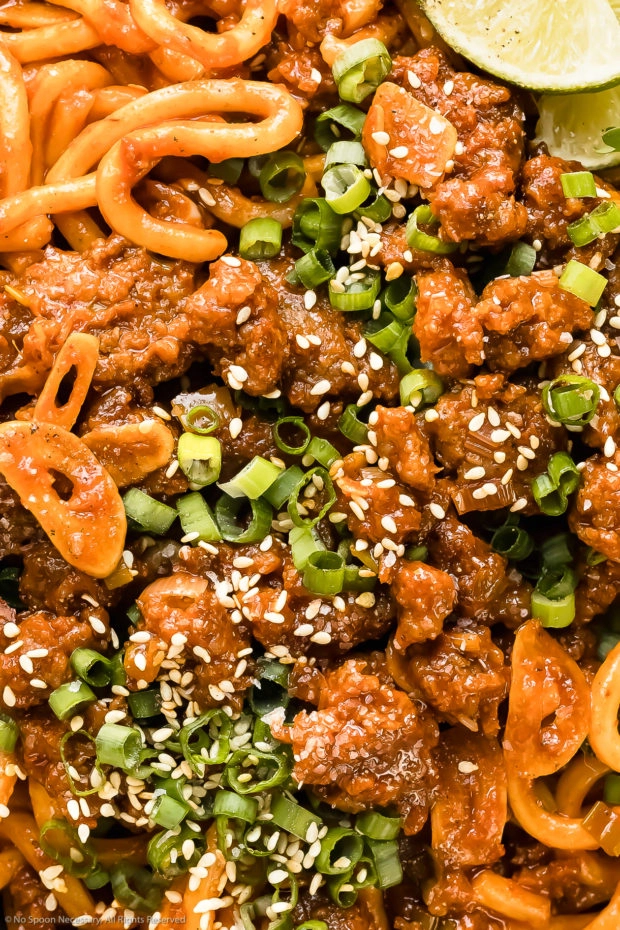

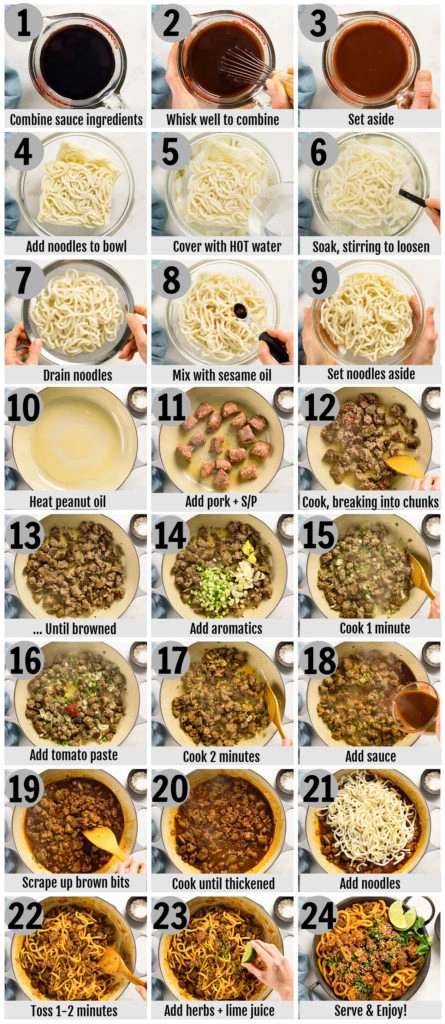

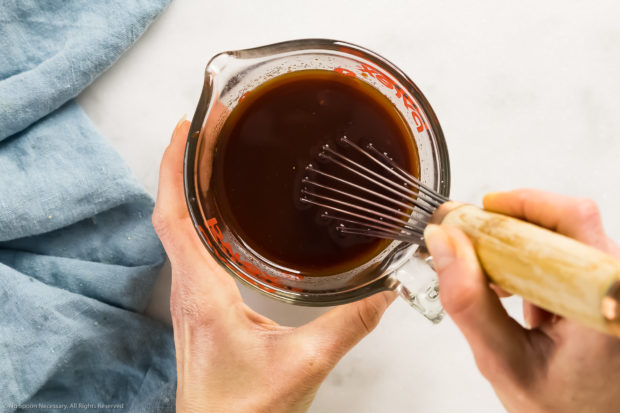


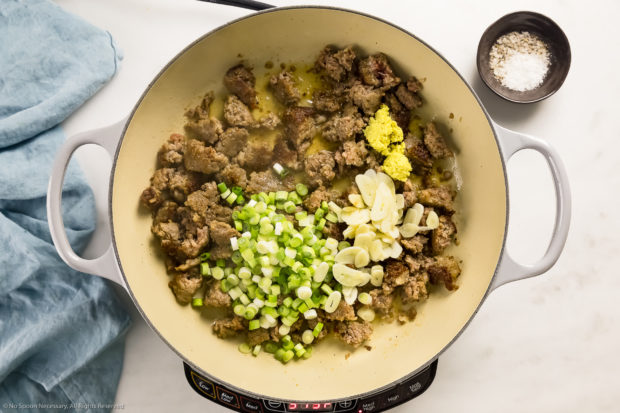
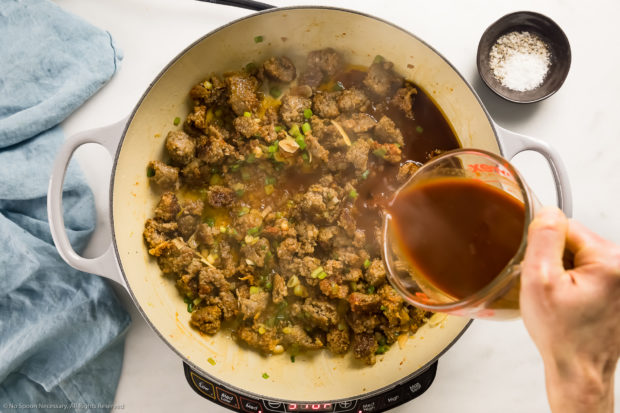
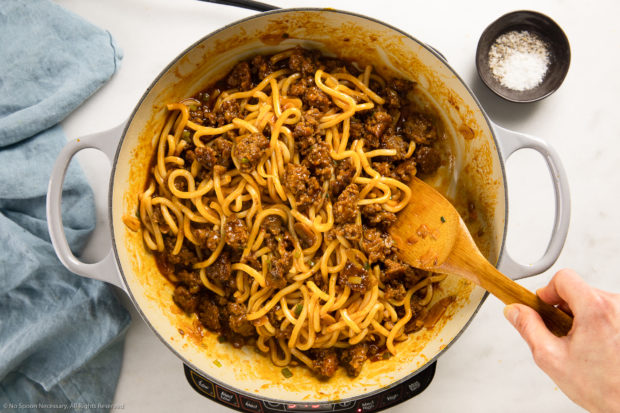
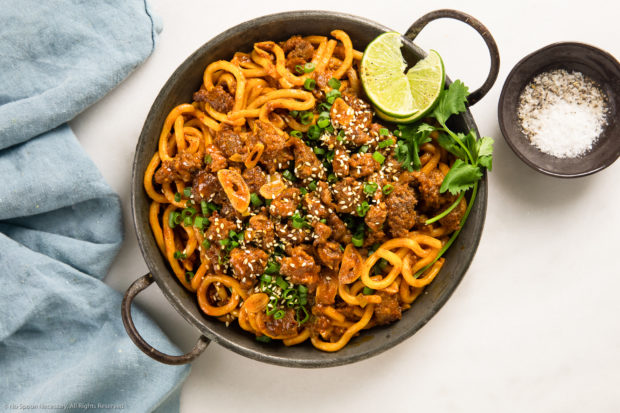
Vicky
Far too much vinegar- 1/3 of a cup?? Together with gojujang it is spur to the point of being inedible.
Cheyanne
Hi Vicky,
Oh my goodness, my sincerest apologies for the error in the recipe card – you are absolutely correct, that is way too much vinegar. Thank you so much for bringing it to my attention. I’ve updated the recipe card and fixed the oversight to reflect the correct measurements. Again, I am so very sorry for that mistake, Vicky – I sincerely apologize.
Cheers and warm wishes for a wonderful weekend,
Cheyanne
Ben | Havocinthekitchen
Gosh, you always describe your recipes so perfectly appealing that I will probably die because of an excessive and uncontrollable drooling one day (Not to mention these terrific photos!) Wait a second – I will need to clean my phone screen lol.
The noodles look utterly delicious, comforting, and inviting…and really, and I mean that, mouthwatering. Pass me the bowl please.
angiesrecipes
I always love the texture of udon. My mom used to make the stirfry with shrimp, lots of bean sprouts, eggs and chives…so good! Your stirfry looks mouthwatering.